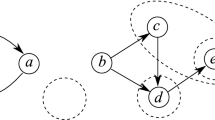Abstract
A canonical (propositional) Gentzen-type system is a system in which every rule has the subformula property, it introduces exactly one occurrence of a connective, and it imposes no restrictions on the contexts of its applications. A larger class of Gentzen-type systems which is also extensively in use is that of quasi-canonical systems. In such systems a special role is given to a unary connective \(\lnot \) of the language (usually, but not necessarily, interpreted as negation). Accordingly, each application of a logical rule in such systems introduces either a formula of the form \(\diamond (\psi _1,\ldots ,\psi _n)\), or of the form \(\lnot \diamond (\psi _1,\ldots ,\psi _n)\), and all the active formulas of its premises belong to the set \(\{\psi _1,\ldots ,\psi _n,\lnot \psi _1,\ldots ,\lnot \psi _n\}\). In this paper we investigate the whole class of quasi-canonical systems. We provide a constructive coherence criterion for such systems, and show that a quasi-canonical system is coherent iff it is analytic iff it has a characteristic non-deterministic matrix (Nmatrix) which is based on some subset of the set of the four truth-values which are used in the famous Dunn–Belnap four-valued (deterministic) matrix for information processing. In addition, we determine when a quasi-canonical system admits (strong) cut-elimination.
Similar content being viewed by others
Notes
The notation “\(\vdash _\mathcal{M}\)” is overloaded here, but this should not cause any confusion.
Note that by (ii), \(\tilde{\lnot }(a)\in \{\{t,\top \},\{f,\bot \},\{t\},\{f\},\{\top \},\{\bot \}\}\).
The theorem holds for infinite sets as well, but we shall not need this fact.
This can be justified by modifying the proof given below in a standard way, using infinite \(\Gamma ^*\) and \(\Delta ^*\).
In addition to the results from Avron (2014) which are generalized and systematized here, that paper includes many other results which are important for the two cases in which \(\lnot \) can be taken as a negation.
References
Anderson, A. R., & Belnap, N. D. (1975). Entailment: The logic of relevance and necessity (Vol. I). Princeton: Princeton University Press.
Avron, A. (2014). Paraconsistency, paracompleteness, Gentzen systems, and trivalent semantics. Journal of Applied Non-Classical Logics, 24(1–2), 12–34.
Avron, A., Arieli, O. & Zamansky, A. (2018). Theory of Effective Propositional Paraconsitent Logics, volume 75 of Studies in logic mathematical logic and foundations. College Publications
Avron, A., & Konikowska, B. (2005). Multi-valued calculi for logics based on non-determinism. Journal of the Interest Group in Pure and Applied Logic, 10, 365–387.
Avron, A., Konikowska, B., & Zamansky, A. (2013). Cut-free sequent calculi for C-systems with generalized finite-valued semantics. Journal of Logic and Computation, 23(3), 517–540.
Avron, A., & Lev, I. (2001). Canonical propositional gentzen-type systems. In: Proceedings of the 1st international joint conference on automated reasoning (IJCAR 2001), LNAI 2083. Springer
Avron, A., & Lev, I. (2005). Non-deterministic multi-valued structures. Journal of Logic and Computation, 15, 241–261.
Avron, A., & Zamansky, A. (2011). Non-deterministic semantics for logical systems—A survey. In D. Gabbay & F. Guenther (Eds.), Handbook of philosophical logic (Vol. 16, pp. 227–304). Berlin: Springer.
Belnap, N. D. (1977). A useful four-valued logic. In J. M. Dunn & G. Epstein (Eds.), Modern uses of multiple-valued logics (pp. 7–37). Dordrecht: Reidel Publishing Company.
Ciabattoni, A., Lahav, O., Spendier, L., & Zamansky, A. (2013). Automated support for the investigation of paraconsistent and other logics. In S. Artemov & A. Nerode (Eds.), Logical Foundations of Computer Science, number 7734 in Lecture Notes in Computer Science (pp. 119–133). Berlin: Springer.
Dunn, J. M. (1976). Intuitive semantics for first-degree entailments and ‘coupled trees’. Philosophical Studies, 29, 149–168.
Acknowledgements
This research was supported by The Israel Science Foundation (Grant No. 817-15).
Author information
Authors and Affiliations
Corresponding author
Rights and permissions
About this article
Cite this article
Avron, A. Quasi-canonical systems and their semantics. Synthese 198 (Suppl 22), 5353–5371 (2021). https://doi.org/10.1007/s11229-018-02045-0
Received:
Accepted:
Published:
Issue Date:
DOI: https://doi.org/10.1007/s11229-018-02045-0




